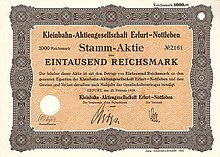Kleinbahn Erfurt – Nottleben
| Erfurt – Nottleben | |||||||||||||||||||||||||||||||||||||||||||||||||||||||||||||||||||||||||||||
|---|---|---|---|---|---|---|---|---|---|---|---|---|---|---|---|---|---|---|---|---|---|---|---|---|---|---|---|---|---|---|---|---|---|---|---|---|---|---|---|---|---|---|---|---|---|---|---|---|---|---|---|---|---|---|---|---|---|---|---|---|---|---|---|---|---|---|---|---|---|---|---|---|---|---|---|---|---|
|
Bindersleben station, 1987
| |||||||||||||||||||||||||||||||||||||||||||||||||||||||||||||||||||||||||||||
| Route number : | 6731 | ||||||||||||||||||||||||||||||||||||||||||||||||||||||||||||||||||||||||||||
| Route length: | 21.24 km | ||||||||||||||||||||||||||||||||||||||||||||||||||||||||||||||||||||||||||||
| Gauge : | 1435 mm ( standard gauge ) | ||||||||||||||||||||||||||||||||||||||||||||||||||||||||||||||||||||||||||||
|
|||||||||||||||||||||||||||||||||||||||||||||||||||||||||||||||||||||||||||||
The Kleinbahn-AG Erfurt-Nottleben opened up the western area of today's state capital of Thuringia, which at the time belonged to the Prussian district of Erfurt, with a standard-gauge railway line . From December 8, 1942, it traded as the Erfurt Nottleben railway company .
Route
The standard-gauge small railway line began in Erfurt Nord, 800 meters from the Wolkramshausen – Erfurt railway station , and led around the city to the Westbahnhof, where the railway administration was located. Then she turned to the west and reached Nottleben via Bindersleben after 21 km , which today belongs to the district of Gotha, while the rest of the area has come to the city of Erfurt. At that time, the state border was to the west of Nottleben, which prevented further construction.
history
Kleinbahn-AG Erfurt-Nottleben was founded after the First World War on October 15, 1924, by the Province of Saxony, the city and district of Erfurt and ten other communities. The share capital was 1.216 million Reichsmarks . As early as 1926 there was a capital increase in which the German Reich and Prussia participated.
On April 15, 1925, the Kleinbahn acquired the 6.6-kilometer-long siding to the former Royal Prussian rifle factory , which had led from Erfurt Nord via Marbach to Lauentor-Strasse west of Petersberg since December 22, 1917. With the installation of a switch at kilometer 5.1, the route was extended to Nottleben. On November 11, 1926, the 21.2-kilometer route was opened. The small railway department of the Provincial Association of Saxony in Merseburg was entrusted with the operational management , which had already drawn up building plans in 1914 and sustainably supported the construction of the railway in difficult times.
In 1934, a new 1.3-kilometer-long siding was built for the Erfurt-Bindersleben air base at 12.2 kilometers , and one for the Heeresverpflegungsamt near Erfurt Marbach in 1939. A correspondingly extensive freight traffic followed with 150 to 180 freight wagons a day. Already in 1939 there was a cessation of the low passenger traffic between Erfurt north and west, since the Westbahnhof had a tram connection since June 20, 1934, whereby the city center or the main train station could be reached much faster.
After the Second World War, the railway was nationalized and operated by the Deutsche Reichsbahn . In the post-war period, passenger traffic comprised up to ten passenger trains a day, but increasingly suffered from competition from the road, so that it was discontinued on August 28, 1967 and replaced by buses. After the closure of the siding to the Optima office machine works on February 1, 1966, goods traffic between Alach and Nottleben was suspended on September 24.
While the western section of the route was no longer used and was dismantled in the following period (1970s), traffic on the remaining route increased again. The large housing estates in the north of Erfurt had to be connected to the city center, and the route ran right through it. In 1976, regular passenger traffic was set up again, coming from the Nordbahnhof to the new Berliner Straße stop ( see Erfurt S-Bahn ). In addition, the line became home to the first regular-gauge traditional railway in the GDR. In the course of the celebrations for “100 years of RBD Erfurt ”, a vehicle exhibition was shown at the Erfurt West train station in June 1982, as well as museum traffic for several days. The great response led to the establishment of a regular museum railway operation from 1983 ("Traditionsbahn Erfurt West"). In the years that followed, steam-hauled museum trains ran on various weekends from the main station via the former small railroad to Erfurt West, and occasionally to Bindersleben.
But when in 1992 the freight traffic to the siding to Erfurt airport was stopped, this also meant the end of the historical traffic; a sale of the route to the honorary museum railroaders failed because of the price. The “S-Bahn” to Berliner Straße ran until May 28, 1995, when the last two trains were also canceled. The only thing left was the freight traffic for the siding of the Marbacher Silo (formerly the Heeresverpflegungsamt), operated until 2003.
The line between Erfurt Nord and Erfurt Marbach was subsequently closed on December 31, 2003. In 2004, the line to Bindersleben, which had already been closed at the end of February 1998 , was dismantled , with the exception of the disused, 4.6 km long freight track from the north station to Erfurt-Marbach . The renatured Marbach has been flowing on the railway line west of the Gera since 2019 . The railway bridge over the Gera was dismantled in November 2018.

